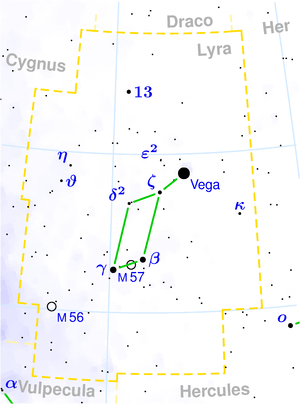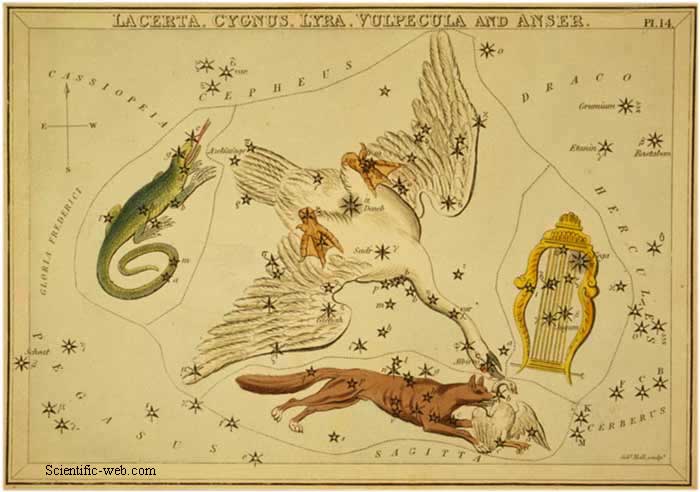- ^ Ian Ridpath and Wil Tirion (2007). Stars and Planets Guide
, Collins, London. ISBN 978-0007251209. Princeton University Press, Princeton. ISBN 978-0691135564.
- ^ a b Star Tales - Lyra. Ian Ridpath's Star Tales. Retrieved on October 17, 2007.
- ^ a b c Autostar Suite Astronomer Edition. CD-ROM. Meade, April 2006.
- ^ a b Star Lore of the Constellations: Lyra the Lyre. skyscript.co.uk. Retrieved on October 17, 2007.
- ^ World_Archaeological_Congress.pdf. The Astronomy of the Boorong. Retrieved on October 17, 2007.
- ^ Allen, Richard Hinckley [1936]. Star Names and Their Meanings. Kessenger Publishing, 532. Retrieved on 2008-03-22].
- ^ D'Altroy, Terence N. [2002]. "The Inca Pantheon", The Incas, The Peoples of America. Oxford: Blackwell Publishing, 149. ISBN 9780631176770. 7. ^ D'Altroy, Terence N. [2002]. "The Inca Pantheon", The Incas, The Peoples of America. Oxford: Blackwell Publishing, 149. ISBN 9780631176770.
|
|
Lyra is one of the 48 constellations listed by Ptolemy, and is one of the 88 modern constellations recognized by the International Astronomical Union. Lyra is a small constellation, but its principal star, Vega, is one of the brightest in the sky. Lyra took its name from the stringed musical instrument well known for its use in Classical Antiquity and still in some areas of Greece.[2] According to ancient Greek mythology, the young god Hermes created the lyre from the body of a large tortoise shell (khelus) which he covered with animal hide and antelope horns. Lyres were associated with Apollonian virtues of moderation and equilibrium, contrasting the Dionysian pipes which represented ecstasy and celebration.[2] Beginning at the north, Lyra is surrounded by the Dragon Draco, the Greek hero Hercules, the Little Fox Vulpecula and Cygnus the swan.[3] Features Here are some of Lyra's brighter stars:[3] * α Lyr (Vega): with an apparent brightness of 0.03m this is the second brightest star of the northern hemisphere (after Arcturus) and the fifth brightest star in all; its spectral class is A0 V and it lies at a distance of only 25.3 ly. * β Lyr (Sheliak): a group of eclipsing binaries is named after this variable star (3.45m, spectral class B8 II), the Beta-Lyrae-stars. * γ Lyr (Sulafat): the main star of this multiple star system is of magnitude 3.24m and spectral class B9 III * δ Lyr: a double star consisting of a blue-white star of mag. 6m and a semi-regular red giant varying between 4m and 5m. * ε Lyr: a well-known quadruple star, also called "the Double Double" because each of the two brighter components is itself a close double. * ζ Lyr: another double star which can be split using binoculars. * RR Lyr: lent its name to a class of pulsating variable rated r superstars the RR Lyrae-stars. Deep sky objects In Lyra can be found the objects M56, M57, and Kuiper 90. M56 is a rather loose globular cluster at a distance of approximately 32,900 light years, with a diameter of about 85 light years. Its apparent brightness is 8.3m. M57 is also known as the "Ring Nebula". It is one of the best known of all planetary nebulae; its integrated magnitude is 8.8m. It is thought to be between 6,000 and 8,000 years old as we see it today. Kuiper 90 is also known as 17 Lyrae C (Gliese 747AB), a red dwarf system near 17 Lyrae, but really at 26 light years from the Sun. Its period is 5 years, and its magnitude is 11.26 in the V band.[3]. BD +36 3317[1], a white star in the young open cluster Stephenson 1, was discovered as a binary eclipsing system by Violat-Bordonau in 2008. Mythology For millennia, Lyra was shown as a vulture or an eagle, and thus the bird was frequently shown with a lyre enclosed in its wings, though often in its beak. The constellation is therefore frequently referred to as Aquila Cadens or vultur cadens, falling eagle or falling vulture.[4] When Orpheus was struck by grief at the death of his wife, he vowed never to fall in love again. He was killed by a group of Thracian women upset with his rejection, they tore him limb from limb and sent his head to the island of Lesbos. After that his lyre was thrown into the river. Zeus sent an eagle to retrive the lyre, and ordered both of them to be placed in the sky.[4] In the film K-PAX the constellation of Lyra is the location of the planet K-PAX which is an inhabited world which orbits twin stars and has seven moons. In Australian Aboriginal Astronomy, Lyra is known by the Boorong people in Victoria as the Malleefowl constellation.[5] Lyra was known as Urcuchillay by the Incas and was worshipped as an animal deity.[6][7] Citations
Retrieved from "http://en.wikipedia.org/"
|
|
||||||||||||


